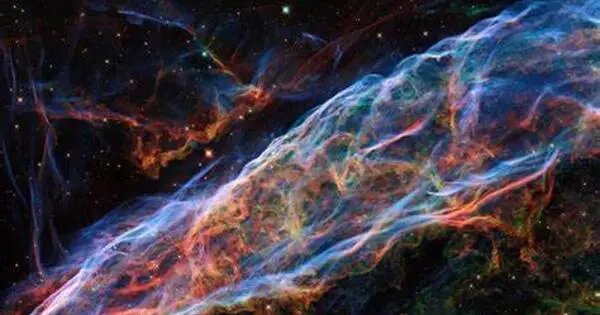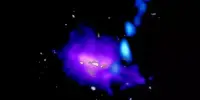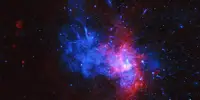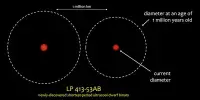Cassiopeia A (Cas A) shines like a shiny, round ornament ready to be placed in the perfect spot on a holiday tree in a new image from NASA’s James Webb Space Telescope. Dr. Jill Biden, First Lady of the United States, debuted the first-ever White House Advent Calendar as part of the 2023 Holidays at the White House. Dr. Biden and NASA are celebrating the “Magic, Wonder, and Joy” of the holiday season with this new image from Webb.
While everything is bright, this is not your typical silent night. Webb’s NIRCam (Near-Infrared Camera) view of Cas A shows this stellar explosion at a resolution previously unattainable at these wavelengths. This high-resolution look unveils intricate details of the expanding shell of material slamming into the gas shed by the star before it exploded.
Cas A is one of the most studied supernova remnants in the universe. Ground- and space-based observatories, including NASA’s Chandra X-Ray Observatory, Hubble Space Telescope, and retired Spitzer Space Telescope, have assembled a multiwavelength picture of the object’s remnant over the years.
Astronomers, on the other hand, have now entered a new era in the study of Cas A. Webb’s MIRI (Mid-Infrared Instrument) began this chapter in April 2023, revealing new and unexpected features within the supernova remnant’s inner shell. Many of these features are missing from the new NIRCam image, and astronomers are looking into why.
With NIRCam’s resolution, we can now see how the dying star absolutely shattered when it exploded, leaving filaments akin to tiny shards of glass behind. It’s really unbelievable after all these years studying Cas A to now resolve those details, which are providing us with transformational insight into how this star exploded.
Danny Milisavljevic
‘Like Shards of Glass’
Because infrared light is invisible to our eyes, image processors and scientists convert these wavelengths of light to visible colors. Colors were assigned to different NIRCam filters in this newest image of Cas A, and each of those colors hints at different activity occurring within the object.
At first glance, the NIRCam image may appear less colorful than the MIRI image. However, this is simply due to the wavelengths at which the material from the object emits its light.
The bright orange and light pink clumps that make up the inner shell of the supernova remnant are the most visible colors in Webb’s latest image. Webb’s razor-sharp vision can detect the tiniest knots of gas from the star itself, which is composed of sulfur, oxygen, argon, and neon. A mixture of dust and molecules is embedded in this gas, which will eventually become components of new stars and planetary systems. Some debris filaments are too small for even Webb to resolve, implying that they are comparable to or less than 10 billion miles across (roughly 100 astronomical units). Cas A, on the other hand, is 10 light-years across, or 60 trillion miles.
“With NIRCam’s resolution, we can now see how the dying star absolutely shattered when it exploded, leaving filaments akin to tiny shards of glass behind,” said Danny Milisavljevic of Purdue University, who leads the research team. “It’s really unbelievable after all these years studying Cas A to now resolve those details, which are providing us with transformational insight into how this star exploded.”
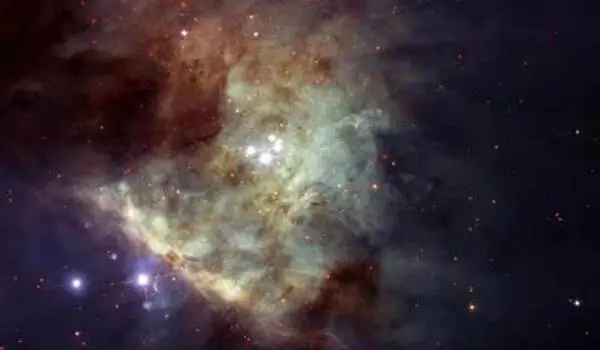
Hidden Green Monster
When comparing Webb’s new near-infrared view of Cas A with the mid-infrared view, its inner cavity and outermost shell are curiously devoid of color.
The outskirts of the main inner shell, which appeared in the MIRI image as a deep orange and red, now resemble smoke from a campfire. This is where the supernova blast wave collides with the surrounding circumstellar material. The dust in the circumstellar material is too cool to detect directly in the near-infrared, but it glows in the mid-infrared.
According to the researchers, the white color is caused by synchrotron radiation, which is emitted across the electromagnetic spectrum, including near-infrared. It is caused by charged particles spiraling around magnetic field lines at extremely high speeds. Synchrotron radiation can also be seen in the bubble-like shells in the inner cavity’s lower half.
The Green Monster, a loop of green light in the central cavity of Cas A that glowed in mid-infrared, was also not visible in the near-infrared view. At the time of their first look, researchers described this feature as “difficult to grasp.”
While the ‘green’ of the Green Monster is not visible in NIRCam, what remains in the near-infrared region can shed light on the enigmatic feature. In the NIRCam image, the circular holes visible in the MIRI image are faintly outlined in white and purple emission, indicating ionized gas. According to researchers, this is due to supernova debris pushing through and sculpting gas left behind by the star before it exploded.
Baby Cas A
Researchers were also absolutely stunned by one fascinating feature at the bottom right corner of NIRCam’s field of view. They’re calling that large, striated blob Baby Cas A — because it appears like an offspring of the main supernova.
This is a light echo, which occurs when light from the star’s long-ago explosion reaches and warms distant dust, which glows as it cools. Researchers are particularly intrigued by the complexity of the dust pattern and Baby Cas A’s apparent proximity to Cas A itself. In reality, Baby Cas A is about 170 light-years away from the supernova remnant.
Several other, smaller light echoes can also be found throughout Webb’s new portrait. The Cas A supernova remnant can be found in the constellation Cassiopeia, 11,000 light-years away. From our perspective, it is thought to have exploded around 340 years ago.
